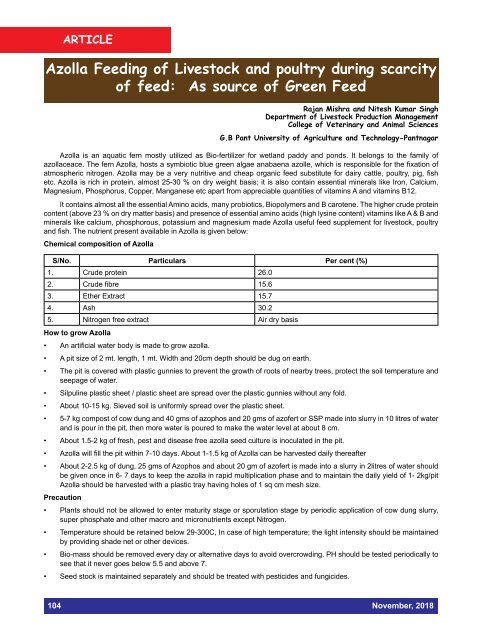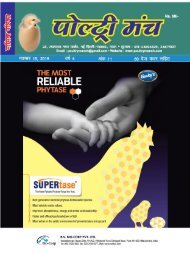November 2018 Punch PDF
Create successful ePaper yourself
Turn your PDF publications into a flip-book with our unique Google optimized e-Paper software.
ARTICLE<br />
Azolla Feeding of Livestock and poultry during scarcity<br />
of feed: As source of Green Feed<br />
Rajan Mishra and Nitesh Kumar Singh<br />
Department of Livestock Production Management<br />
College of Veterinary and Animal Sciences<br />
G.B Pant University of Agriculture and Technology-Pantnagar<br />
Azolla is an aquatic fern mostly utilized as Bio-fertilizer for wetland paddy and ponds. It belongs to the family of<br />
azollaceace. The fern Azolla, hosts a symbiotic blue green algae anabaena azolle, which is responsible for the fixation of<br />
atmospheric nitrogen. Azolla may be a very nutritive and cheap organic feed substitute for dairy cattle, poultry, pig, fish<br />
etc. Azolla is rich in protein, almost 25-30 % on dry weight basis; it is also contain essential minerals like Iron, Calcium,<br />
Magnesium, Phosphorus, Copper, Manganese etc apart from appreciable quantities of vitamins A and vitamins B12.<br />
It contains almost all the essential Amino acids, many probiotics, Biopolymers and B carotene. The higher crude protein<br />
content (above 23 % on dry matter basis) and presence of essential amino acids (high lysine content) vitamins like A & B and<br />
minerals like calcium, phosphorous, potassium and magnesium made Azolla useful feed supplement for livestock, poultry<br />
and fish. The nutrient present available in Azolla is given below:<br />
Chemical composition of Azolla<br />
S/No. Particulars Per cent (%)<br />
1. Crude protein 26.0<br />
2. Crude fibre 15.6<br />
3. Ether Extract 15.7<br />
4. Ash 30.2<br />
5. Nitrogen free extract Air dry basis<br />
How to grow Azolla<br />
• An artificial water body is made to grow azolla.<br />
• A pit size of 2 mt. length, 1 mt. Width and 20cm depth should be dug on earth.<br />
• The pit is covered with plastic gunnies to prevent the growth of roots of nearby trees, protect the soil temperature and<br />
seepage of water.<br />
• Silpuline plastic sheet / plastic sheet are spread over the plastic gunnies without any fold.<br />
• About 10-15 kg. Sieved soil is uniformly spread over the plastic sheet.<br />
• 5-7 kg compost of cow dung and 40 gms of azophos and 20 gms of azofert or SSP made into slurry in 10 litres of water<br />
and is pour in the pit, then more water is poured to make the water level at about 8 cm.<br />
• About 1.5-2 kg of fresh, pest and disease free azolla seed culture is inoculated in the pit.<br />
• Azolla will fill the pit within 7-10 days. About 1-1.5 kg of Azolla can be harvested daily thereafter<br />
• About 2-2.5 kg of dung, 25 gms of Azophos and about 20 gm of azofert is made into a slurry in 2litres of water should<br />
be given once in 6- 7 days to keep the azolla in rapid multiplication phase and to maintain the daily yield of 1- 2kg/pit<br />
Azolla should be harvested with a plastic tray having holes of 1 sq cm mesh size.<br />
Precaution<br />
• Plants should not be allowed to enter maturity stage or sporulation stage by periodic application of cow dung slurry,<br />
super phosphate and other macro and micronutrients except Nitrogen.<br />
• Temperature should be retained below 29-300C, In case of high temperature; the light intensity should be maintained<br />
by providing shade net or other devices.<br />
• Bio-mass should be removed every day or alternative days to avoid overcrowding. PH should be tested periodically to<br />
see that it never goes below 5.5 and above 7.<br />
• Seed stock is maintained separately and should be treated with pesticides and fungicides.<br />
104 <strong>November</strong>, <strong>2018</strong>





